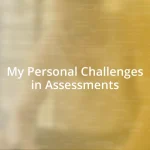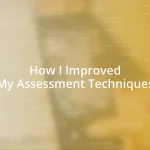Key takeaways:
- CIAs prioritize stakeholder engagement, allowing community voices to influence project outcomes and promote equity.
- Successful assessments utilize various tools, such as GIS and surveys, to gather comprehensive data and address community needs effectively.
- Building trust and addressing challenges like distrust and conflicting interests are crucial for effective community assessments and collaboration.

Understanding Community Impact Assessments
When I first encountered Community Impact Assessments (CIAs), I was intrigued by how they blend social, economic, and environmental factors to evaluate potential projects. The idea that these assessments could highlight the needs and concerns of local communities felt revolutionary. Have you ever wondered how many important voices go unheard in decision-making processes? CIAs are designed to ensure that doesn’t happen.
In my experience, the most compelling part of CIAs is their emphasis on stakeholder engagement. I remember attending a community meeting where residents passionately shared their views on a proposed development. Their concerns about traffic congestion and loss of green spaces were eye-opening for the planners. It made me realize how CIAs serve not just as a tool for assessment, but as a platform for community voices to influence outcomes.
Understanding CIAs also means recognizing their role in promoting equity. Each assessment can uncover disparities that might not be visible at first glance. I recall working on a project where the CIA revealed that a low-income neighborhood lacked access to basic services, like grocery stores and healthcare. It was a poignant reminder that true community impact is not just about economic growth; it’s about uplifting every member of the community, ensuring no one is left behind.

Importance of Community Engagement
Engaging with the community is essential for any project aiming for positive impact. I recall a time when a local park renovation project turned into a conversation rather than a simple decision. Community members brought their life stories and aspirations to the table, emphasizing the importance of accessibility and play areas for children. It reinforced my belief that genuine engagement can lead to well-rounded solutions that reflect community needs.
Moreover, promoting active participation cultivates trust between stakeholders and residents. There was a project once where the initial proposal faced resistance due to a lack of communication. However, after hosting open forums, stakeholders began to understand the community’s perspective, which shifted the project’s trajectory towards a more inclusive approach. I’ve seen firsthand how this type of engagement fosters a collaborative spirit, ultimately steering projects toward success.
When communities feel heard and valued, they become more invested in the outcomes. I remember watching residents take ownership of initiatives that stemmed from genuine engagement efforts. It was heartwarming to see how empowered they felt, knowing their opinions played a crucial role in shaping decisions that affect their lives. The emotional connection fostered through participation truly transforms the landscape of community projects.
| Aspect | Benefits of Community Engagement |
|---|---|
| Building Trust | Enhanced communication fosters relationships between stakeholders and residents. |
| Empowering Voices | Community members feel valued and can influence project outcomes. |
| Improving Outcomes | Engagement leads to better, more inclusive solutions reflecting community needs. |

Steps in Conducting Assessments
Conducting Community Impact Assessments (CIAs) requires a systematic approach to ensure thorough understanding and effective outcomes. My process often begins with gathering relevant data, which can include demographic information, existing community resources, and previous project outcomes. I remember the first time I delved into community statistics; it was like unlocking a treasure trove of insights that helped shape my perspective on the genuine needs of the area.
- Define the scope and objectives of the assessment.
- Collect and analyze quantitative and qualitative data.
- Engage with community stakeholders through surveys and meetings.
- Evaluate potential impacts, both positive and negative.
- Prepare and share findings with stakeholders, ensuring transparency.
As I dive deeper into the process, I find that drafting recommendations based on the assessment’s findings is a critical step. This part can be challenging but rewarding. I once participated in a project where our recommendations spurred drastic changes, like incorporating more green spaces and ensuring public transport accessibility. The community’s reaction was overwhelmingly positive, which highlighted the power of well-informed suggestions tailored to their unique context.

Tools for Effective Assessments
When it comes to tools for effective Community Impact Assessments, I find that technology plays a pivotal role. Utilizing Geographic Information Systems (GIS) can illuminate spatial data like population density and area resources, making the complex layers of community dynamics more digestible. I remember the first time I layered different data sets on a map; it felt like stepping into a new dimension of understanding—the visualization really puts things into perspective!
Surveys and questionnaires are also invaluable tools. They provide direct feedback and gauge community sentiment, which often leads to eye-opening revelations. I once conducted a survey for a community center project, and the results underscored a need for youth programs I hadn’t initially considered. It was a game changer and made me realize how silent needs can speak volumes when given the chance to be heard.
Lastly, engaging in focus groups allows for in-depth discussions that surface qualitative insights. These conversations can turn into shared stories that resonate deeply. I can still hear the passion in the voices of local residents when they articulated their dreams for a safer neighborhood. This feedback not only shapes assessments but also builds an emotional tapestry of community aspirations that should never be overlooked. What tools have you found impactful in your assessments?

Analyzing Assessment Outcomes
Analyzing the outcomes of Community Impact Assessments (CIAs) can sometimes feel like peering through a window into the heart of a community. I remember a particular project where we evaluated the effectiveness of a new youth program. The data showed increased participation rates, but what truly moved me were the stories shared during follow-up interviews—young people talking about how the program changed their lives and brought them hope. It’s moments like these that reveal the real impact behind the numbers.
As I review assessment findings, I often find it essential to distinguish between quantitative and qualitative data. While numbers can illustrate trends, personal stories can create deeper connections. On one occasion, after analyzing community feedback, I discovered that residents didn’t just want more parks; they craved spaces for community gatherings and festivals. This insight taught me that it’s vital to listen closely—sometimes, the most meaningful outcomes stem from understanding the emotions behind the data.
I also believe that sharing outcomes with the community is crucial. When I presented results to stakeholders after a recent assessment, I felt a palpable shift in the room—what started as a simple presentation evolved into a vibrant discussion about future possibilities. Engaging everyone transforms the assessment from a mere report into a shared vision, allowing people to imagine what could be achieved together. Have you ever experienced this kind of collective enthusiasm when discussing outcomes? It’s profoundly motivating and demonstrates how collaborative efforts can lead to effective change.

Challenges in Community Assessments
The journey of conducting Community Impact Assessments is not without its hurdles. One of the most significant challenges I’ve faced is the ever-present issue of community distrust. In one instance, I approached a neighborhood to gather feedback for a local initiative, only to be met with skepticism about my intentions. It was a stark reminder that past experiences can create barriers, making it crucial to invest time in building relationships before even beginning the assessment. How can we bridge that gap? I believe it starts with transparency and consistent engagement.
Another obstacle I regularly encounter is the difficulty of obtaining representative data. Not every community member will engage in surveys or focus groups, skewing the results. I vividly recall a project dealing with a disenfranchised area where participation was disproportionately low among certain demographics. Despite our best efforts, the voices we gathered didn’t fully reflect the community’s diversity. This experience underscored for me the importance of employing multiple outreach strategies. How do we ensure every voice is heard, especially the quieter ones? Exploring alternative channels and utilizing community leaders can be a game changer.
Lastly, navigating conflicting interests within the community can be quite challenging. During a particular assessment, I found myself in the middle of a heated debate between two factions with opposing visions for a community park. It was a balancing act to facilitate dialogue without favoring one side over the other. This taught me the importance of remaining neutral and creating a safe space for all voices to be heard. What strategies can we utilize to foster collaboration amid discord? I’ve learned that focusing on shared goals can often lead to productive conversations and innovative solutions that benefit everyone involved.

Case Studies of Successful Assessments
One of the most compelling case studies I encountered involved a community health project aimed at reducing diabetes rates. We initiated a CIA that gathered feedback through workshops, where residents shared their struggles and successes around health choices. A participant’s story about transforming their lifestyle after joining a community walking group touched me deeply. It highlighted how sometimes, the most impactful assessments are those where community voices ignite genuine change and inspire others to take action.
In another instance, I observed the transformation of a public library after we conducted an assessment to understand its role in the community. Community members expressed not just a need for more books, but also a desire for cultural programs that celebrate local heritage. Their yearning for connection resonated with me, leading to the creation of multicultural events. This project emphasized how successful assessments can reshape not just facilities, but also the fabric of community engagement, fostering inclusiveness and understanding.
Lastly, I think of a housing initiative we reviewed, where assessments led to real outcomes. During our evaluation, we learned that families wanted more than just affordable housing; they sought safe play areas for their children and access to public transportation. Implementing these findings was enlightening. I noticed renewed enthusiasm among community members—I even witnessed a mom in tears because the park design incorporated elements inspired by her childhood. Isn’t that what true community assessment is about? Connecting deeply with people and translating those insights into actions that spark joy and hope.















